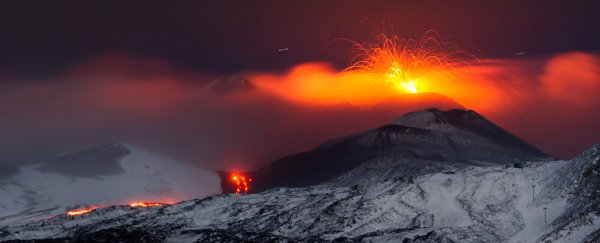Even the most fearsome forces of nature can't escape the laws of physics: the fiery furnace of Mount Etna is slowly sliding into the Mediterranean Sea at a steady rate, according to the latest measurements.
It's the first time scientists have been able to observe the movement of a volcano in its entirety, thanks to more than 100 GPS stations dotted around the sides of Mount Etna, which have been logging positional data for the past 11 years.
The slide is slow but has now become unstoppable, scientists say – and as the volcano sinks, we could be looking at a series of extra hazards for those around the area of Sicily, including the hordes of tourists and scientists who regularly turn up to take a peek at the natural wonder.
 GPS stations were used to track volcano movement. (Murray et al)
GPS stations were used to track volcano movement. (Murray et al)
"Previous studies of long-extinct volcanoes found those sliding downslope in a similar way have resulted in catastrophic landslides later in their history," says lead researcher John Murray, from The Open University in the UK.
"Constant movement could contribute to a major landslide along Etna's coast, causing devastating tsunamis to surrounding areas."
This persistent movement is also going to pose problems for volcanologists, according to Murray, making it harder to predict when the next eruptions are going to occur and in which direction the magma might spew.
Eruptions of varying degrees and types happen every few years on Mount Etna, and it's crucial that scientists can make accurate readings of what's happening and when.
There's no immediate cause for concern, the researchers say, though further detailed studies of Mount Etna are going to be necessary to make sure we're not caught unawares by eruptions, landslides, or tsunamis.
The data shows the volcano moving in a general east-south-east direction, down a slope of 1-3 degrees. It's shifting ever-so-slightly towards the coastal town of Giarre, which is about 15 kilometres (9.3 miles) away.
As well as using the figures gathered in the field, the researchers also built a simulated volcano base in a lab to further examine what might be happening.
At an average rate of 14 millimetres (0.55 inches) a year, the residents of Giarre don't need to pack their bags in any rush, but the danger is if this slow movement starts building up stresses and strains that will lead to larger shifts in the landscape.
"The thing to watch I guess is if in 10 years' time the rate of movement has doubled, that would be a warning," Murray told Jonathan Amos at the BBC. "If it's halved, I'd say there really is nothing to worry about."
This isn't just about Mount Etna either – the measurements taken by Murray and his team could prove useful in the study of other volcanoes around the world, and how the underlying topography can cause volcano shift.
In this case the researchers think that the weak sediments underneath Mount Etna could be lubricating the downhill motion of the 3,329-metre (10,922-foot) volcano. Ultimately that could lead to "large scale slope failure", but the team is keen to emphasise that there's no need to panic.
With such regular eruptions, it's also difficult to pin down exactly how Mount Etna might develop and shift in the future. Let's just keep a close eye on it.
"Around one million people live on Etna and its immediate surroundings, so the destruction of property and loss of life could be catastrophic," Murray told Mark Molloy at The Telegraph. "But I cannot emphasise enough that there is no sign of this happening at the present time."
"Clearly even the mention of such a dangerous event would be very unnerving for the people who live on Etna, so I am anxious that they don't get the wrong impression."
The research has been published in the Bulletin of Volcanology.
